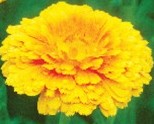 Pot marigold is a short lived herbaceous perennial in the aster family (Asteraceae) native to southern Europe but cultivated now all over the world. It grows up to two feet tall and has pale green hairy lanceolate leaves two to seven inches long. The flower heads consist of yellow or orange florets and are 1.5 to 2.5 inches across. Pot marigold tolerates many kinds of soil but grows best in fertile soil that is moist but well drained. In warm climates it may grow year round a trait the ancient Romans noticed and gave it the name Calendula because it was in bloom the first of every month (kalendae= first day of the month). The common name pot marigold comes from use of the flower in cooking an its association with the Virgin Mary. Calendula should not be confused with African or French marigolds which are in the genus Tagetes; Calendula has curved seeds whereas Tagestes have long, dark seeds.
Pot marigold is a short lived herbaceous perennial in the aster family (Asteraceae) native to southern Europe but cultivated now all over the world. It grows up to two feet tall and has pale green hairy lanceolate leaves two to seven inches long. The flower heads consist of yellow or orange florets and are 1.5 to 2.5 inches across. Pot marigold tolerates many kinds of soil but grows best in fertile soil that is moist but well drained. In warm climates it may grow year round a trait the ancient Romans noticed and gave it the name Calendula because it was in bloom the first of every month (kalendae= first day of the month). The common name pot marigold comes from use of the flower in cooking an its association with the Virgin Mary. Calendula should not be confused with African or French marigolds which are in the genus Tagetes; Calendula has curved seeds whereas Tagestes have long, dark seeds.
Pot marigold has a peppery, spicy taste and imparts a yellow color to foods so is known as “poor man’s saffron’. It has been used for centuries to color cheese and butter but is also used to add flavor to fish dishes, soups, stews, pasta, rice, salads, custards, puddings, egg dishes including quiche, and baked goods such as cornbread, cake, and cookies. Calendula flowers can also be used to make a delicious wine and a medicinal tea.
Harvest the flower heads in the morning when they are fully open. Wash and spin dry if you wish and then pull the petals from their centers. The petals can be used immediately or dried for future use. Forty to sixty flowers will yield one cup of fresh petals.